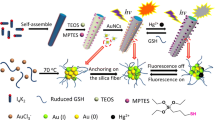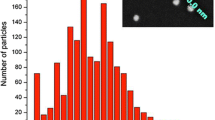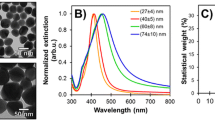Abstract
Recent advancements in metal-enhanced fluorescence (MEF) suggest that it can be a promising tool for detecting molecules at very low concentrations when a fluorophore is fixed near the surface of metal nanoparticles. We report a simple method for aggregating multiple gold nanoparticles (GNPs) on Rhodamine B (RhB)-doped silica nanoparticles (SiNPs) utilizing dithiocarbamate (DTC) chemistry to produce MEF in solution. Dye was covalently incorporated into the growing silica framework via co-condensation of a 3-aminopropyltriethoxysilane (APTES) coupled RhB precursor using the Stöber method. Electron microscopy imaging revealed that these mainly non-spherical particles were relatively large (80 nm on average) and not well defined. Spherical core-shell particles were prepared by physisorbing a layer of RhB around a small spherical silica particle (13 nm) before condensing an outer layer of silica onto the surface. The core-shell method produced nanospheres (~30 nm) that were well defined and monodispersed. Both dye-doped SiNPs were functionalized with pendant amines that readily reacted with carbon disulfide (CS2) under basic conditions to produce DTC ligands that have exhibited a high affinity for gold surfaces. GNPs were produced via citrate reduction method and the resulting 13 nm gold nanospheres were then recoated with an ether-terminated alkanethiol to provide stability in ethanol. Fluorescent enhancement was observed when excess GNPs were added to DTC coated dye-doped SiNPs to form nanoparticle aggregates. Optimization of this system gave a fluorescence brightness enhancement of over 200 fold. Samples that gave fluorescence enhancement were characterized through Transmission Emission Micrograph (TEM) to reveal a pattern of multiple aggregation of GNPs on the dye-doped SiNPs.






Similar content being viewed by others
References
Drummen GPC (2012) Fluorescent probes and fluorescence (Microscopy) techniques — illuminating biological and biomedical research. Molecules 17(12):14067–14090
Lakowicz JR (2006) Plasmonics in biology and plasmon-controlled fluorescence. Plasmonics 1(1):5–33
Anker JN, Hall WP, Lyandres O, Shah NC, Zhao J, van Duyne RP (2008) Biosensing with plasmonic nanosensors. Nat Mater 7(6):442–453
Aslan K, Lakowicz JR, Geddes CD (2005) Plasmon light scattering in biology and medicine: new sensing approaches, visions and perspectives. Curr Opin Chem Biol 9(5):538–544
Lakowicz JR (1999) Principles of Fluorescent Spectroscopy, 2nd edn. Springer, New York, p 725
Punj D, de Torres J, Rigneault H, Wenger J (2013) Gold nanoparticles for enhanced single molecule fluorescence analysis at micromolar concentration. Opt Express 21(22):27338–27343
Kühn S, Håkanson U, Rogobete L, Sandoghdar V (2006) Enhancement of single-molecule fluorescence using a gold nanoparticle as an optical nanoantenna. Phys Rev Lett 97(1):017402
Butler SJ, Lamarque L, Pal R, Parker D (2014) Eurotracker dyes: highly emissive europium complexes as alternative organelle stains for live cell imaging. Chem Sci 5:1750–1756
Geddes CD, Gryczynski I, Malicka J, Gryczynski Z, Lakowicz JR (2003) Metal-enhanced fluorescence: potential applications in HTS. Comb Chem High Throughput Screen 6(2):109–117
Jain PK, Huang X, El-Sayed IE, El-Sayed MA (2008) Nobel metals on the nanoscale: optical and photothermal properties and same applications in imaging, sensing, biology, and medicine. Acc Chem Res 41(12):1578–1586
Lakowicz JR, Ray K, Chowdhury M, Szmacinski H, Fu Y, Zhang J, Nowaczyk K (2008) Plasmon-controlled fluorescence: a new paradigm in fluorescence spectroscopy. Analyst 133:1308–1346
Aslan K, Gryczynski I, Malicka J, Matveeva E, Lakowicz JR, Geddes CD (2005) Metal-enhanced fluorescence: an emerging tool in biotechnology. Curr Opin Biotechnol 16(1):55–62
Zhang J, Lakowicz JR (2007) Metal-enhanced fluorescence of an organic fluorophore using gold particles. Opt Express 15(5):2598
Geddes CD, Lakowicz JR (2002) Metal-enhanced fluorescence. J Fluoresc 12(2):121–130
Dragan AI, Bishop ES, Casas-Finet JR, Strouse RJ, McGivney J, Schenerman MA, Geddes CD (2012) Distance dependence of metal-enhanced fluorescence. Plasmonics 7:739–744
Liu J, Li A, Tang J, Wang R, Kong N, Davis TP (2012) Thermoresponsive silver/polymer nanohybrids with switchable metal enhanced fluorescence. Chem Commun 48:4680–4682
Tam F, Goodrich GP, Johnson BR, Halas NJ (2007) Plasmonic enhancement of molecular fluorescence. Nano Lett 7(2):496–501
Zhang Y, Dragan A, Geddes CD (2009) Wavelength dependence of metal-enhanced fluorescence. J Phys Chem C 113(28):12095–12100
Zhang J, Fu Y, Chowdhury MH, Lakowicz JR (2008) Single-molecule studies on fluorescently labeled silver particles: effects of particle size. J Phys Chem C 112:18–26
Kelly LE, Coronado E, Zhao LL, Schatz GC (2003) The optical properties of metal nanoparticles: the influence of size, shape, and dielectric environment. J Phys Chem B 107(3):668–677
Quinten M, Leitner A, Krenn J, Aussenegg F (1998) Electromagnetic energy transport via linear chains of silver nanoparticles. Opt Lett 23(17):1331–1333
Hao E, Schatz GC (2004) Electromagnetic fields around silver nanoparticles and dimers. J Chem Phys 120:357
Su KH, Wei QH, Zhang X, Mock J, Smith D, Schultz S (2003) Interparticle coupling effects on plasmon resonances of nanogold particles. Nano Lett 3(8):1087–1090
Zhang J, Fu Y, Chowdhury MH, Lakowicz JR (2007) Metal-enhanced single-molecule fluorescence on silver particle monomer and dimer: coupling effect between metal particles. Nano Lett 7(7):2101–2107
Acuna GP, Moller FM, Holzmeister P, Beater S, Lalkens B, Tinnefeld P (2012) Fluorescence enhancement at docking sites of DNA-directed self-assembled nanoantennas. Science 338:506–510
Pan S, Wang Z, Rothberg LJ (2006) Enhancement of adsorbed dye monolayer fluorescence by a silver nanoparticle overlayer. J Phys Chem B 110:1783–17387
Aslan K, Lakowicz JR, Szmacinski H, Geddes CD (2004) Metal-enhanced fluorescence solution-based sensing platform. J Fluoresc 14(6):677–679
Aslan K, Wu M, Lakowicz JR, Geddes CD (2007) Fluorescent core-shell Ag@ SiO2 nanocomposites for metal-enhanced fluorescence and single nanoparticle sensing platforms. J Am Chem Soc 129(6):1524–1525
Furtaw MD, Lin D, Wu L, Anderson JP (2009) Near-infrared metal-enhanced fluorescence using a liquid–liquid droplet micromixer in a disposable poly (Methyl Methacrylate) microchip. Plasmonics 4(4):273–280
Wang L, Tan W (2006) Multicolor FRET silica nanoparticles by single wavelength excitation. Nano Lett 6(1):84–88
Ma D, Tan S, Jakubek ZJ, Simard B (2009) On the Structural Stability of Dye-Doped Silica Nanoparticles. IEEE Nano:651–655
Hartlen K, Athanasopoulos A, Kitaev V (2008) Facile preparation of highly monodisperse small silica spheres (15 to >200 nm) suitable for colloidal templating and formation of ordered arrays. Langmuir 24:1714–1720
Frens G (1972) Controlled nucleation for the regulation of the particle size in monodisperse gold suspensions. Nature Phys Sci 241:20–22
Polte J, Ahner TT, Delissen F, Sokolov S, Emmerling F, Thunemann AF, Kraehnert R (2010) Mechanism of gold nanoparticle formation in the classical citrate synthesis method derived from coupled in situ XANES and SAXS evaluation. J Am Chem Soc 132:1296–1301
Singh A (2012) Cucurbit[7]uril mediated viologen-fluorophore dyad for fluorescence off/on switch. Dissertation, University of Oklahoma
Gunawardana KB (2012) Study of Metal Enhanced Fluorescence of Dye-Doped silica Nanopartilces. Dissertation, University of Oklahoma
Liu X, Atwater M, Wang J, Huo Q (2007) Extinction coefficient of gold nanoparticles with different sizes and different capping ligands. Colloids Surf B: Biointerfaces 58(1):3–7
Near RD, Hayden SC, Hunter RE, Thackston D, El-Sayed MA (2013) Rapid and efficient prediction of optical extinction coefficients for gold nanospheres and gold nanorods. J Phys Chem C 117:23950–23955
Zhao Y, Pérez-Segarra W, Shi Q, Wei A., Dithiocarbamate assembly on gold. J. Am. Chem. Soc. 127 (20):7328
Park MH, Ofir Y, Samanta B, Arumugam P, Miranda OR, Rotello VM (2008) Nanoparticle immobilization on surfaces via activatable heterobifunctional dithiocarbamate bond formation. Adv Mater 20:4185–4188
Gunawardana KB, Halterman RL (2011) Metal enhanced fluorescence of dye-doped silica nanoparticles. SWRM 898
Green NS, Gunawardana KB, Costello, WN, Halterman RL (2012) Metal enhanced fluorescence of dye-doped silica nanoparticles. SWRM 423
Vanderkooy A, Chen Y, Ferdinand G, Brook MA (2011) Silica shell/gold core nanoparticles: correlating shell thickness with the plasmonic red shift upon aggregation. ACS Appl Mater Interfaces 3:3942–3947
Halterman RL, Moore JL, Yip WT (2011) Cucurbit[7]uril disrupts aggregate formation between rhodamine B dyes covalently attached to glass substrates. J Fluoresc 21:1467–1478
Lazarides AA, Schatz GC (2000) DNA-linked metal nanosphere materials: structural basis for the optical properties. J Phys Chem B 104(3):460–467
Lakowicz JR (2005) Radiative decay engineering 5: metal-enhanced fluorescence and plasmon emission. Anal Biochem 337:171–194
Acknowledgments
We thank the NSF for funding this work (DMR – 0805233). We thank Anuradha Singh for providing S-10-[2-(2 methoxyethoxy)ethoxy]decyl ethanethioate (CH3O(CH2CH2O)C10H20SOCH3) for GNP surface functionalization.
Author information
Authors and Affiliations
Corresponding author
Electronic supplementary material
Below is the link to the electronic supplementary material.
ESM 1
(PDF 918 kb)
Rights and permissions
About this article
Cite this article
Gunawardana, K.B., Green, N.S., Bumm, L.A. et al. Metal-Enhanced Fluorescence of Dye-Doped Silica Nano Particles. J Fluoresc 25, 311–317 (2015). https://doi.org/10.1007/s10895-015-1510-8
Received:
Accepted:
Published:
Issue Date:
DOI: https://doi.org/10.1007/s10895-015-1510-8




